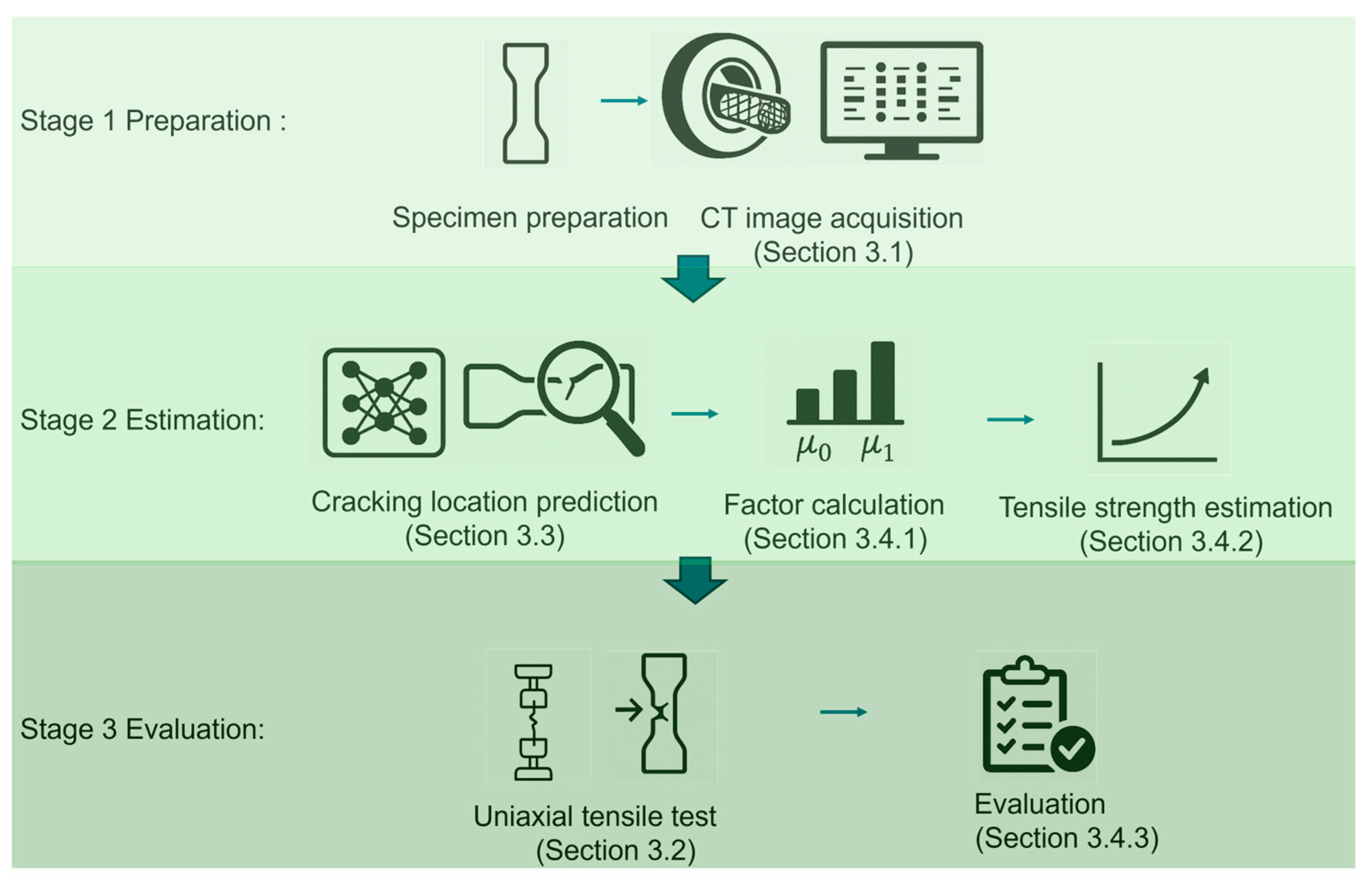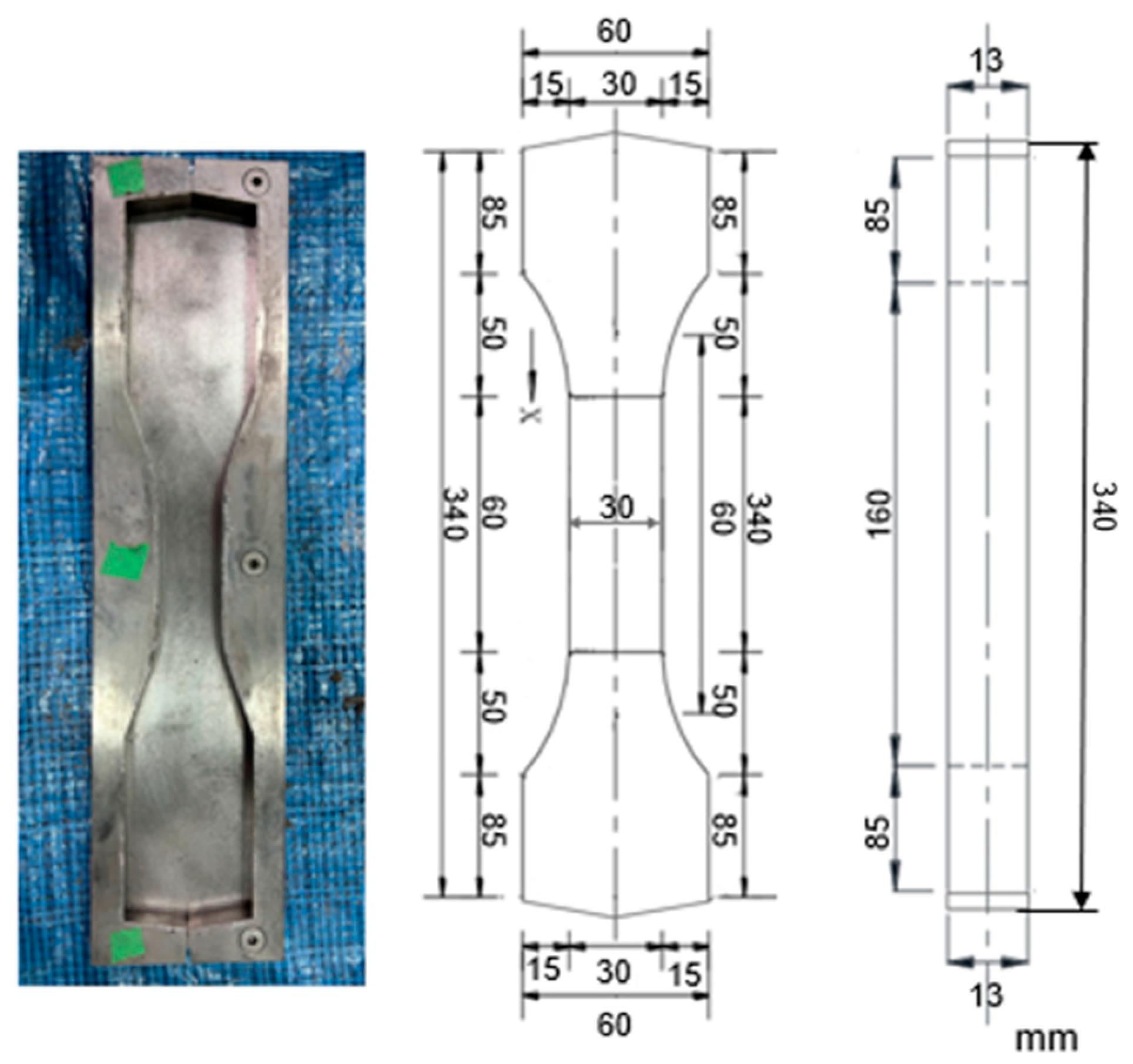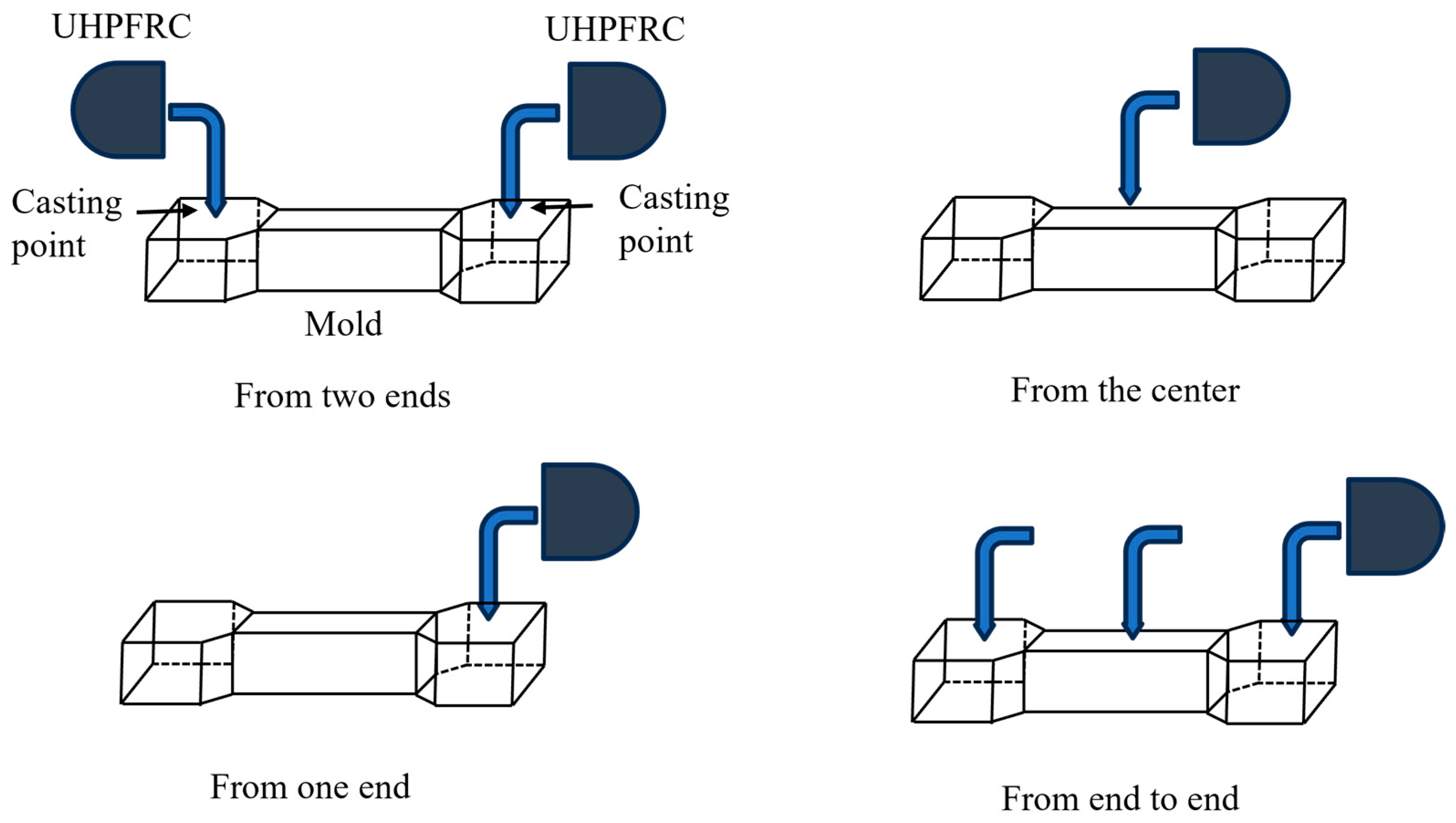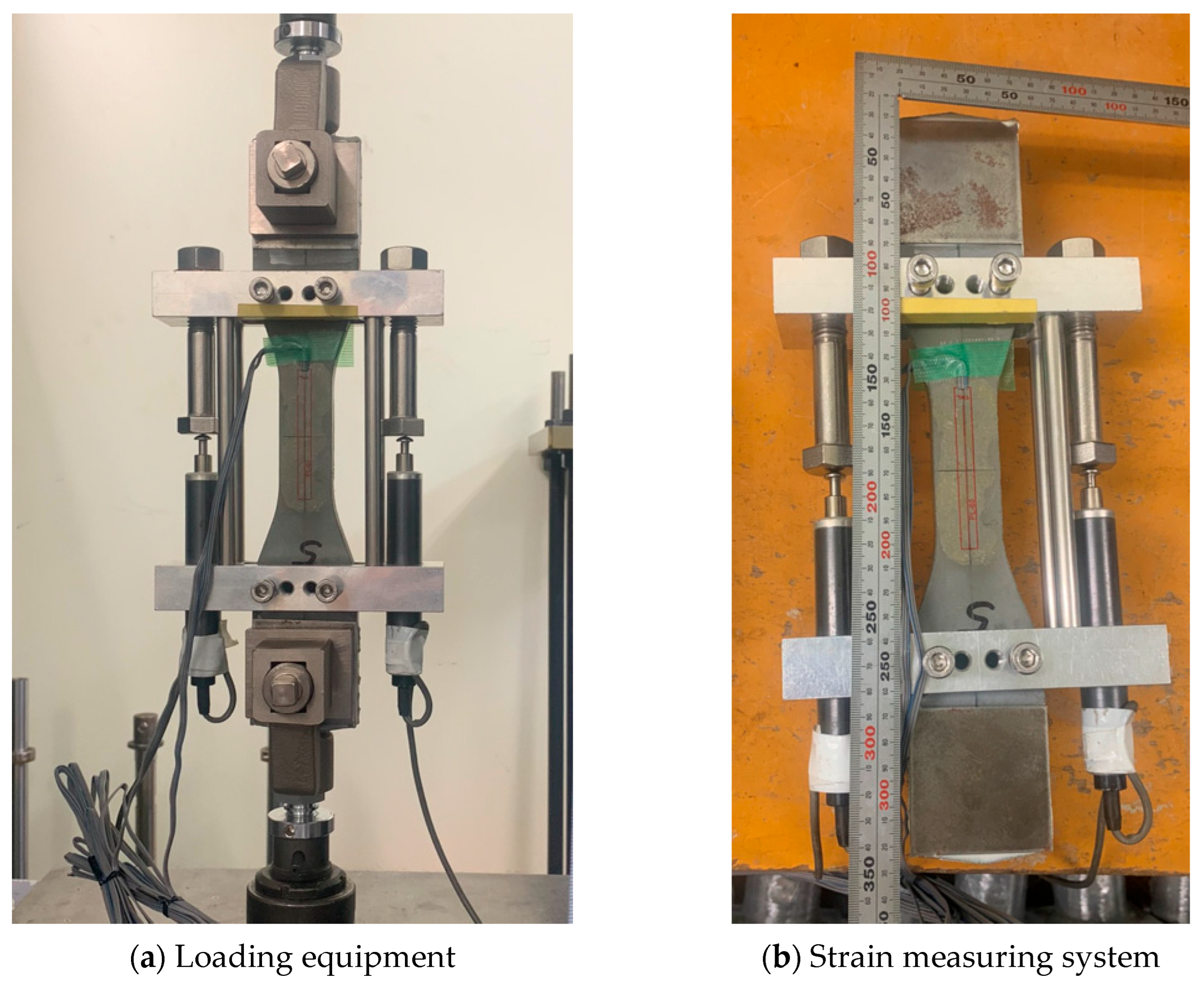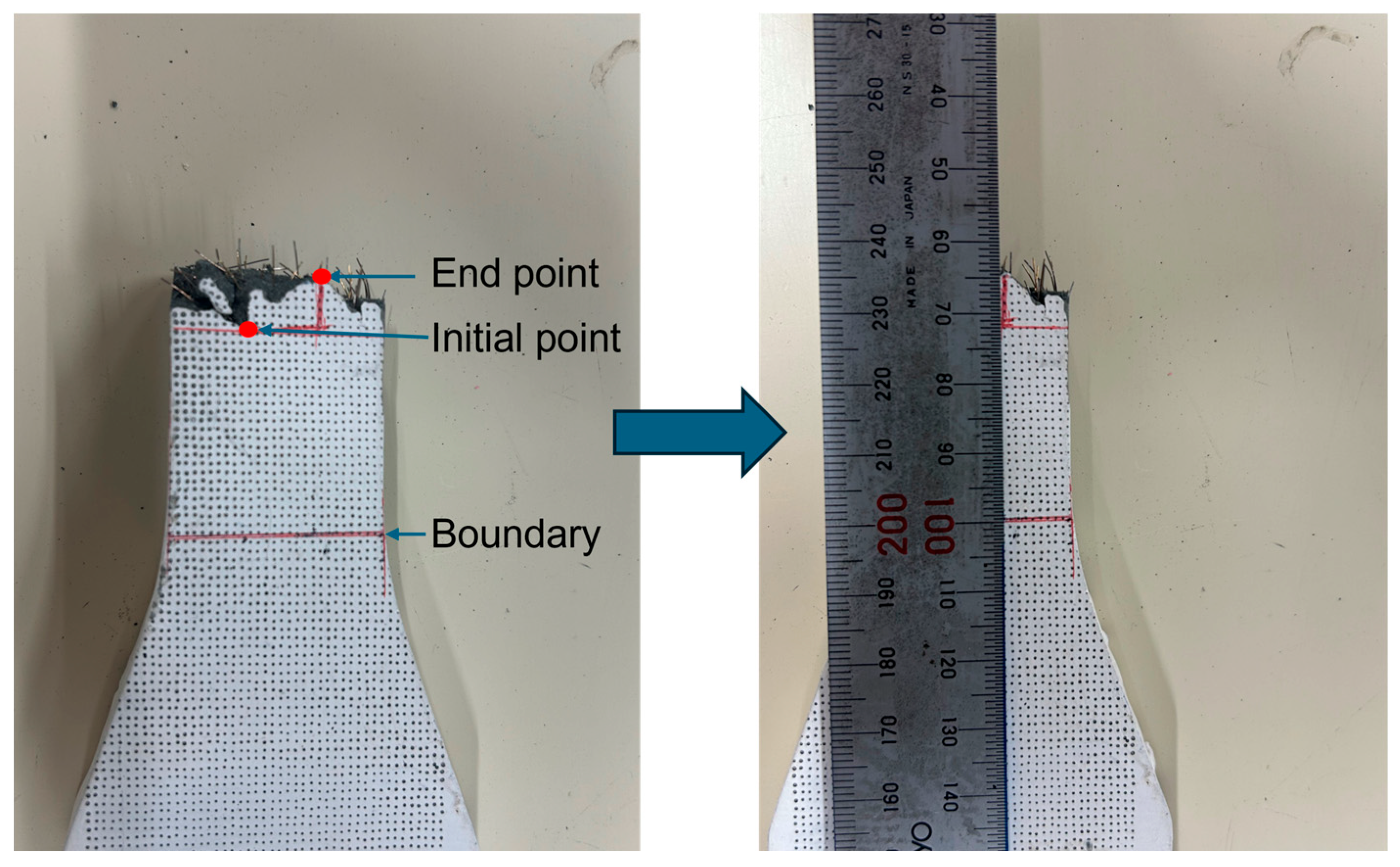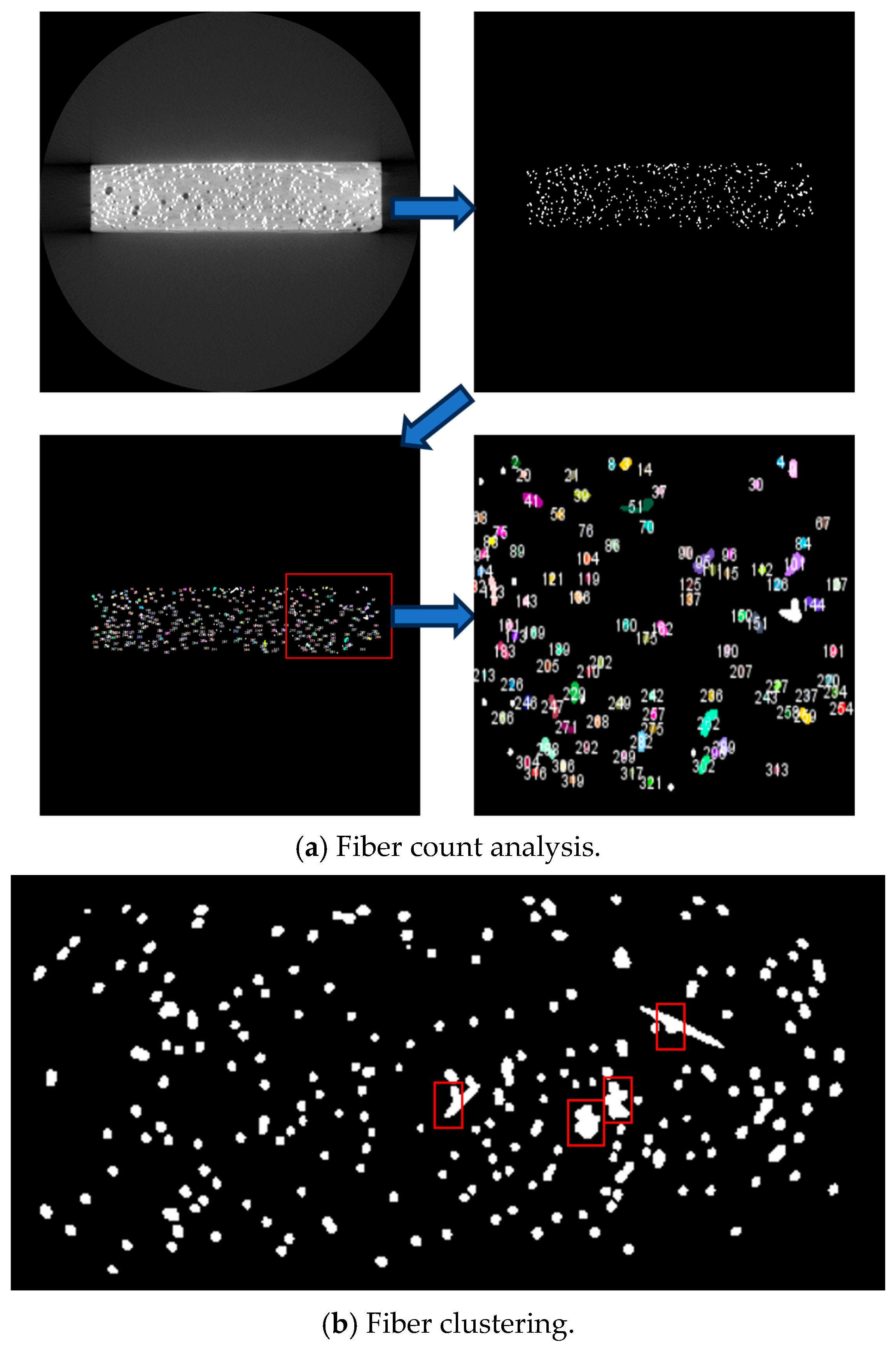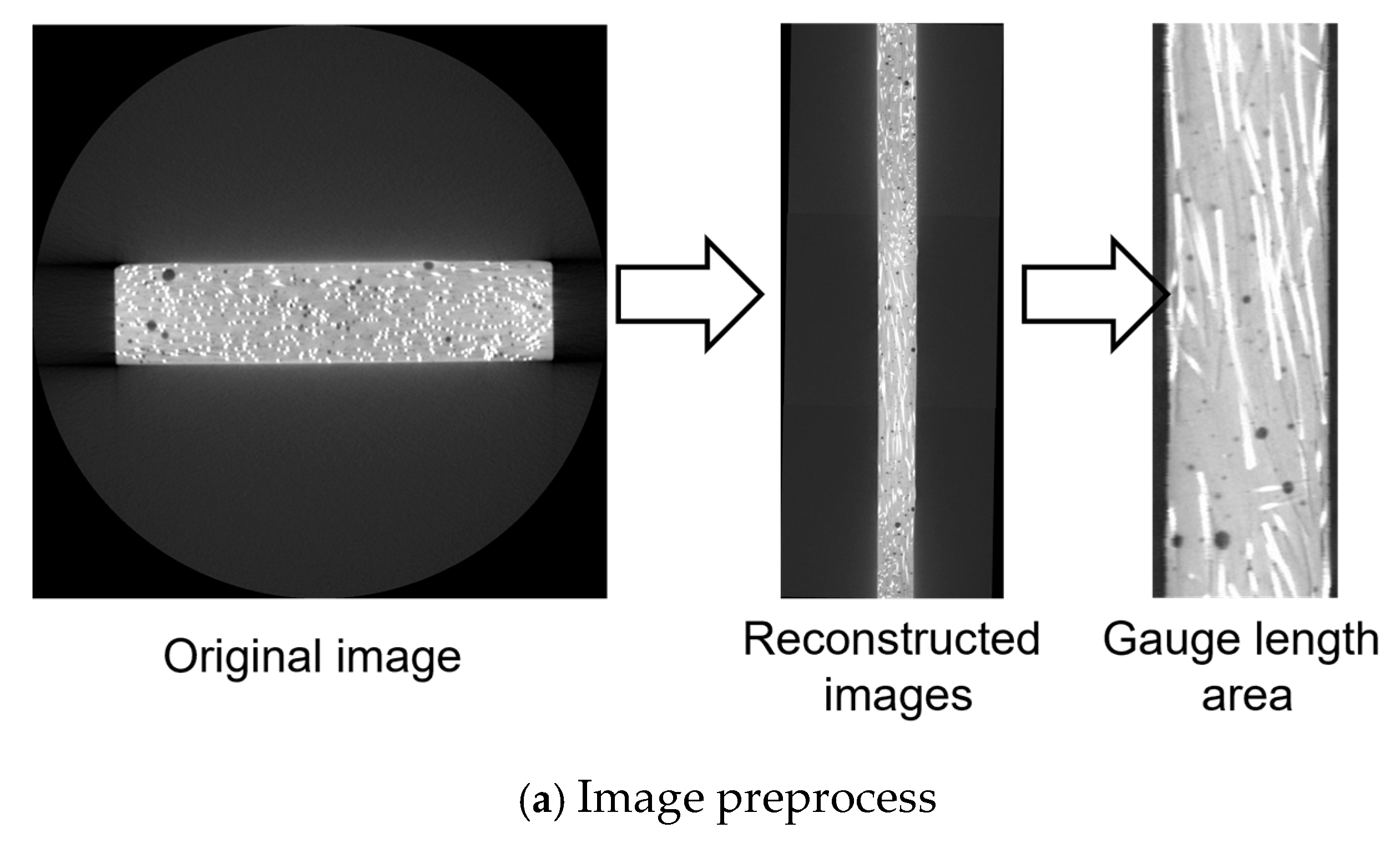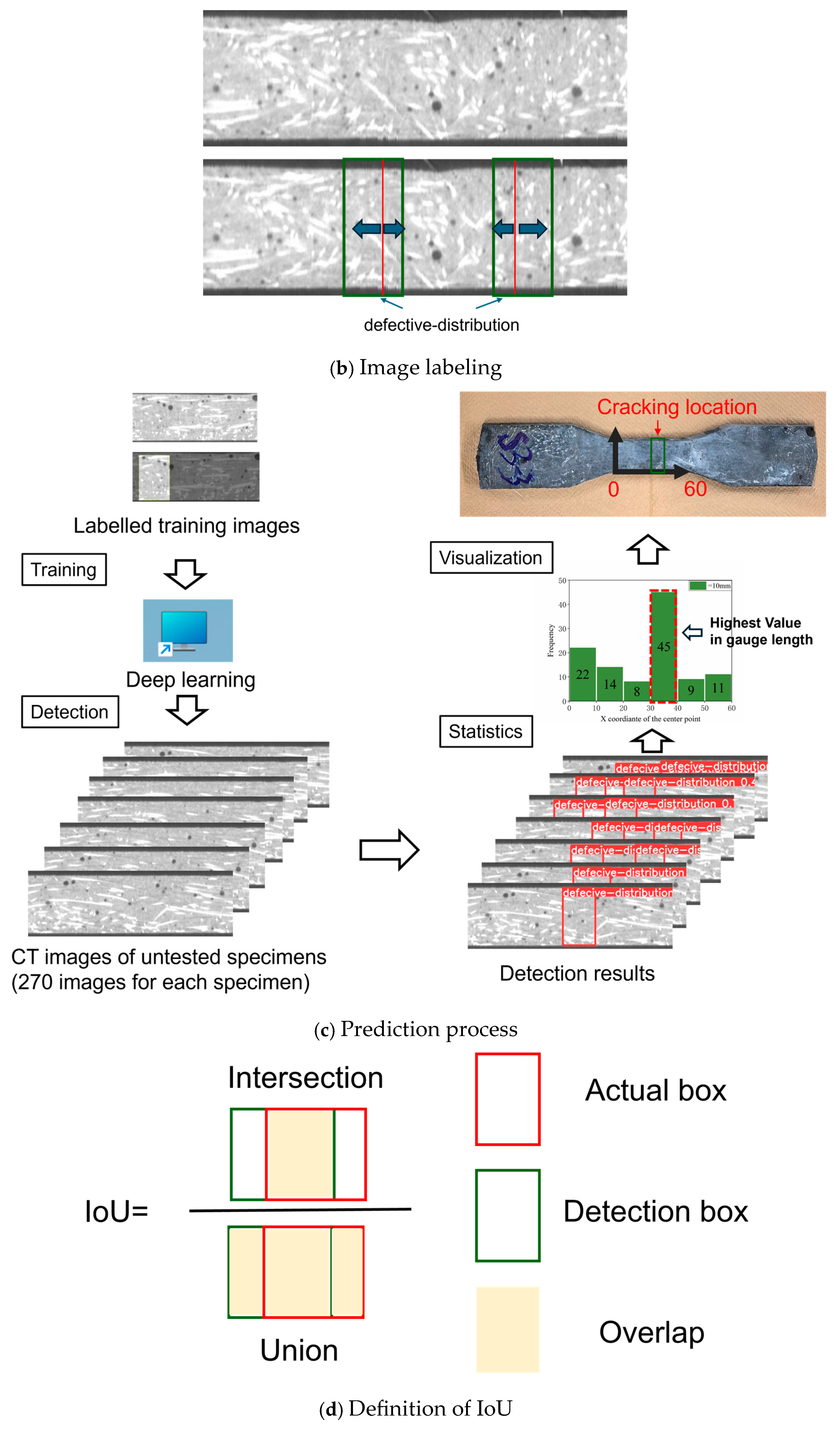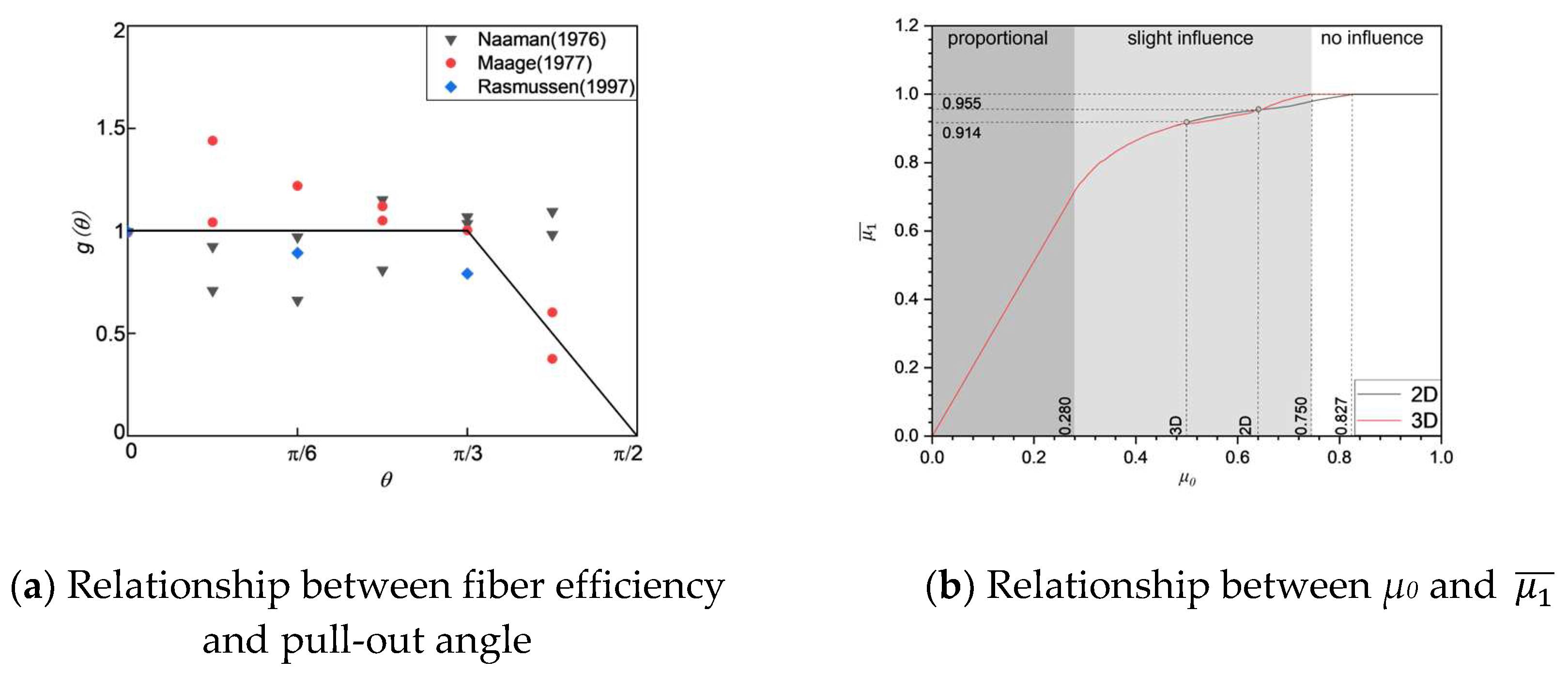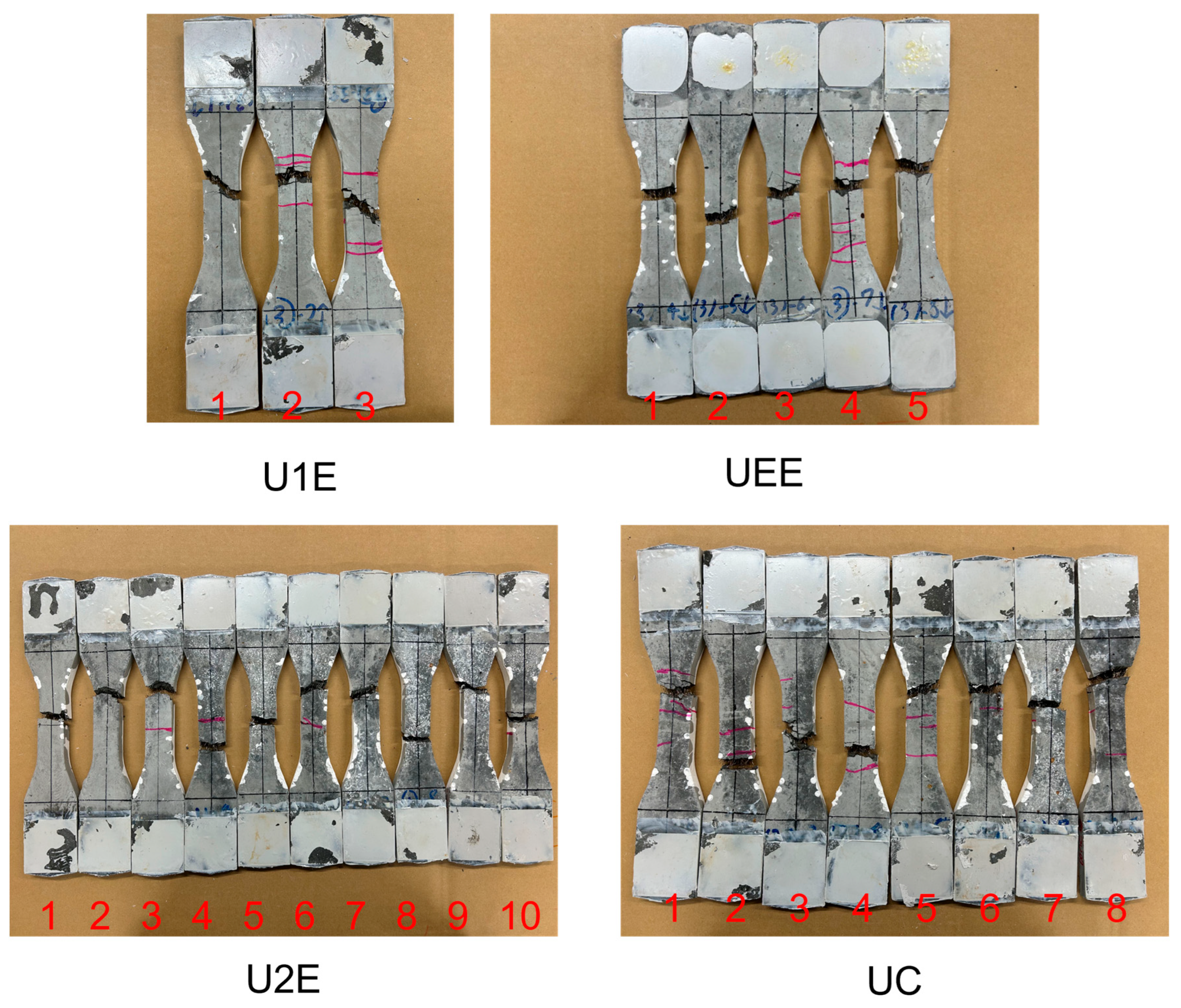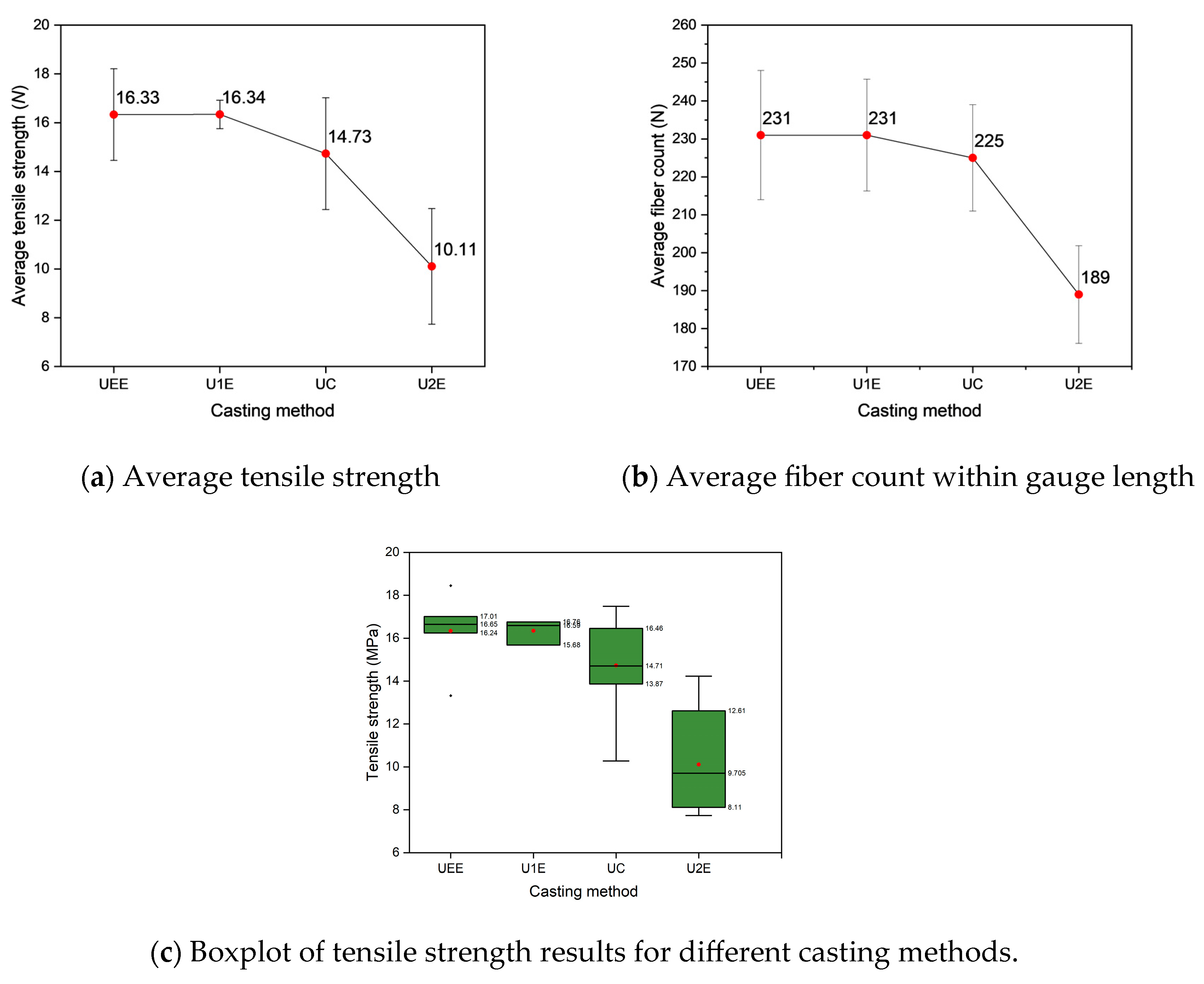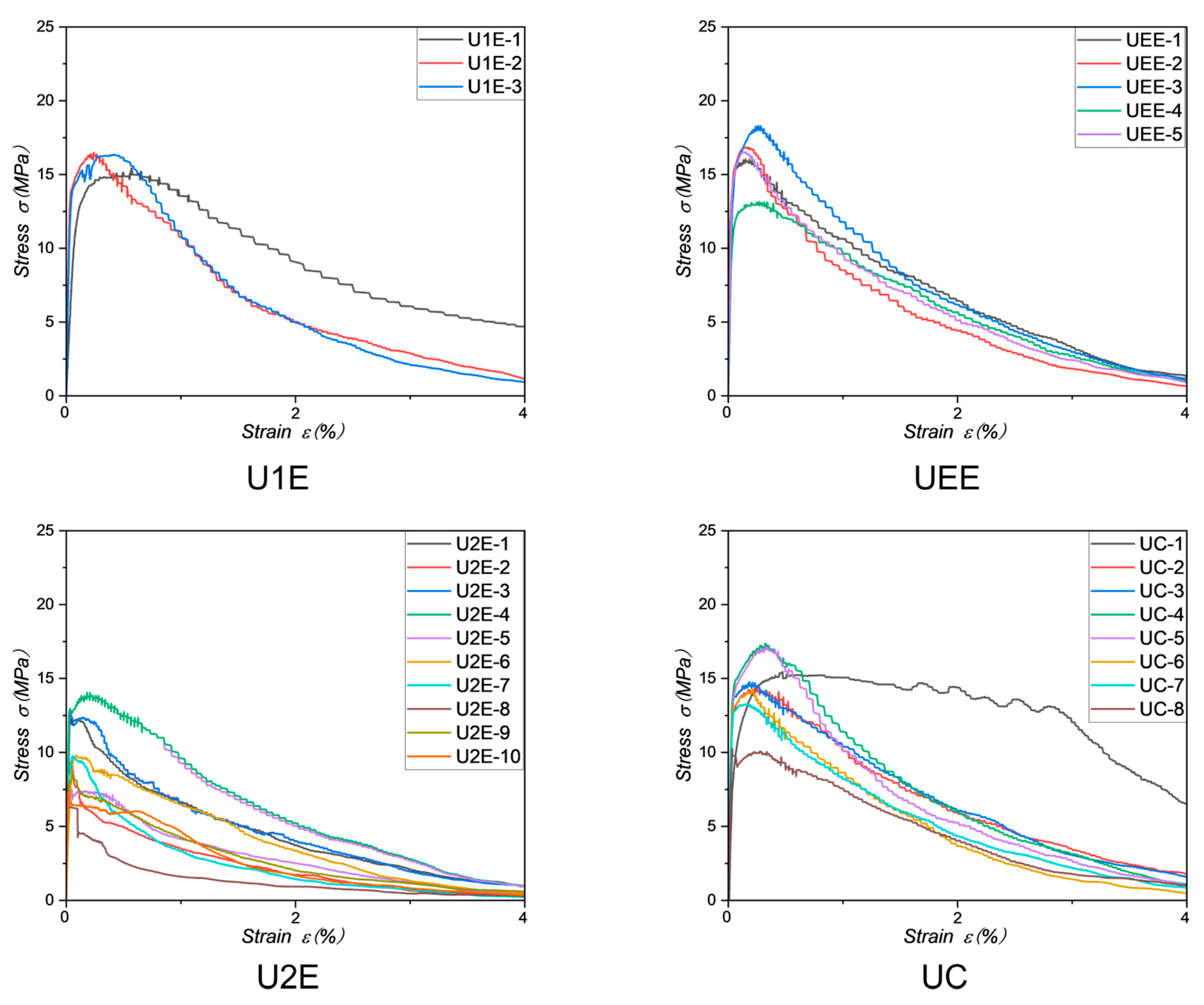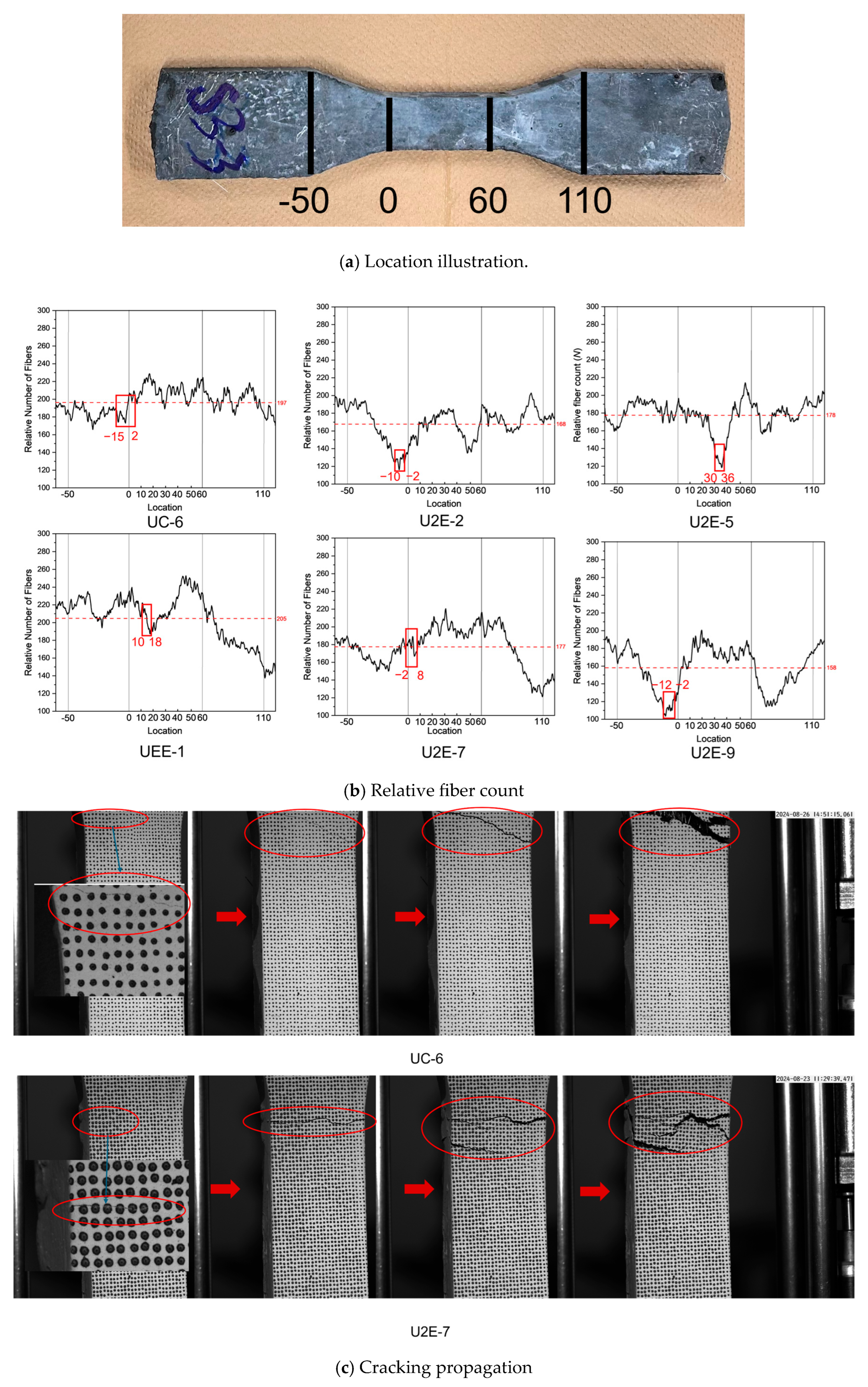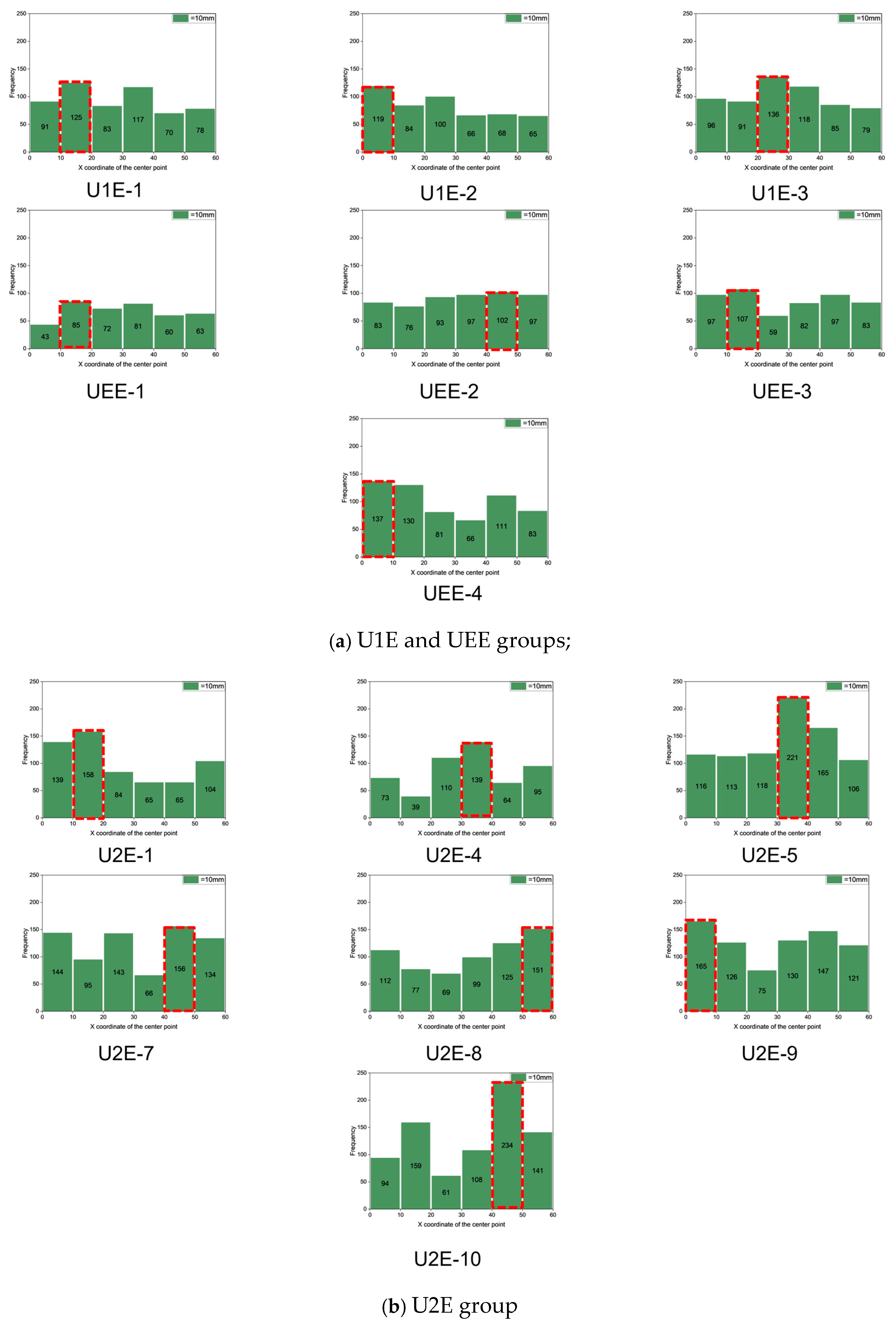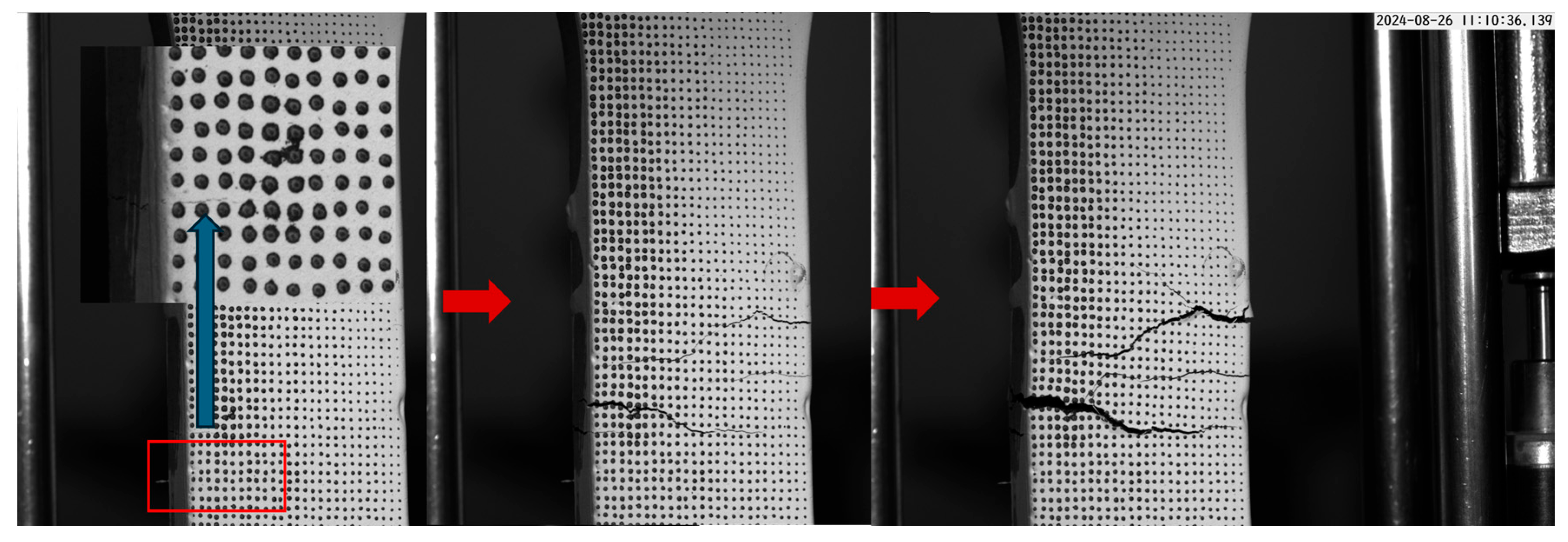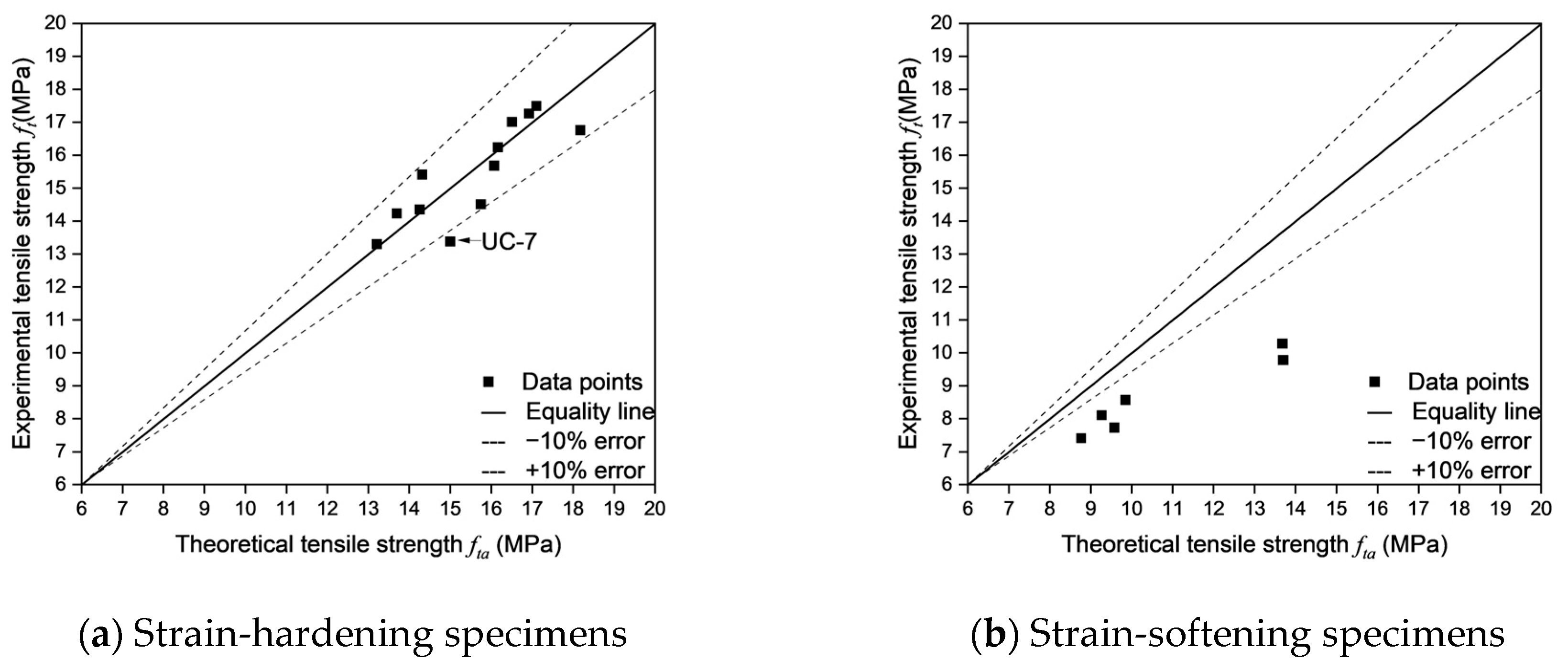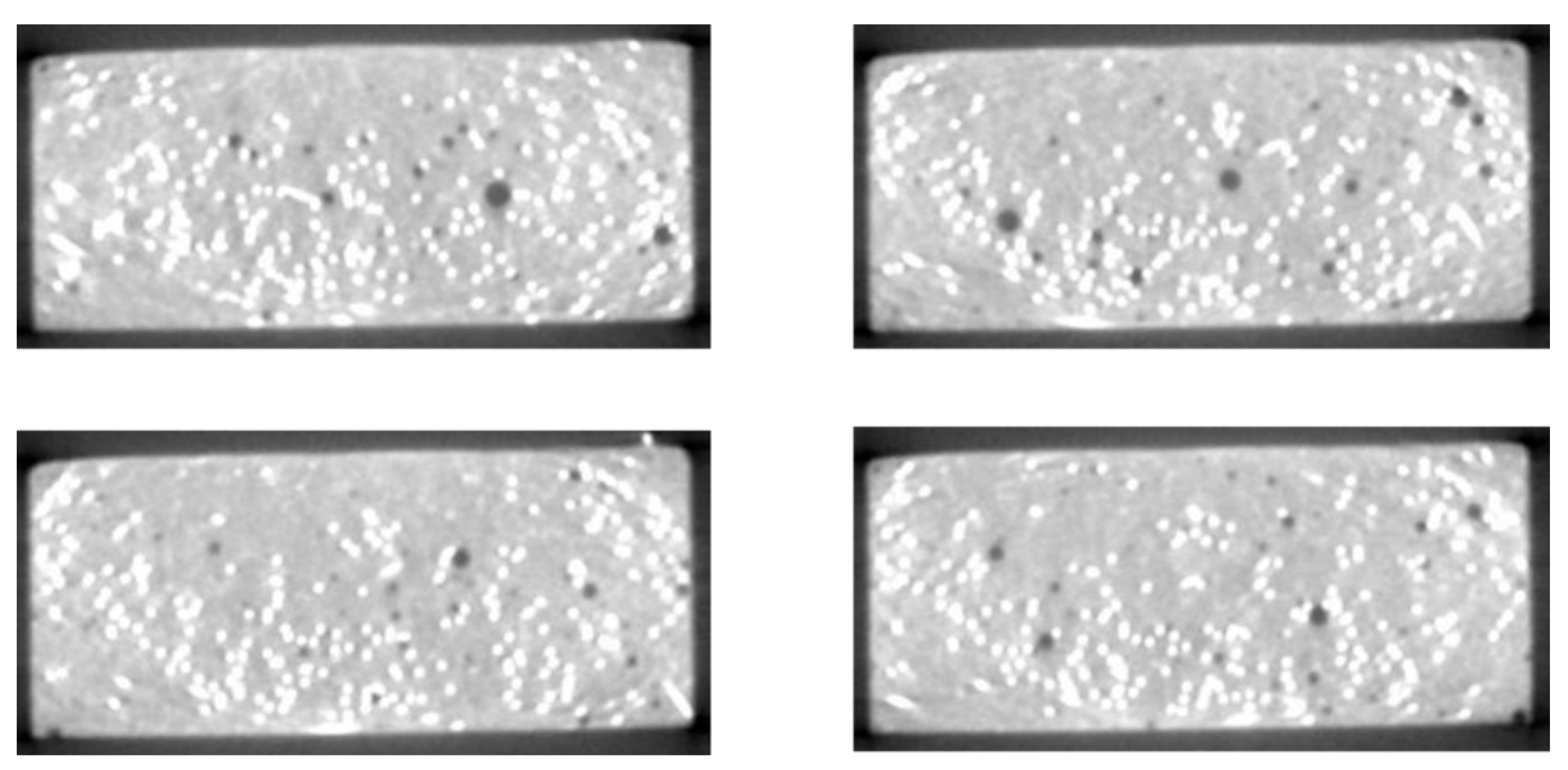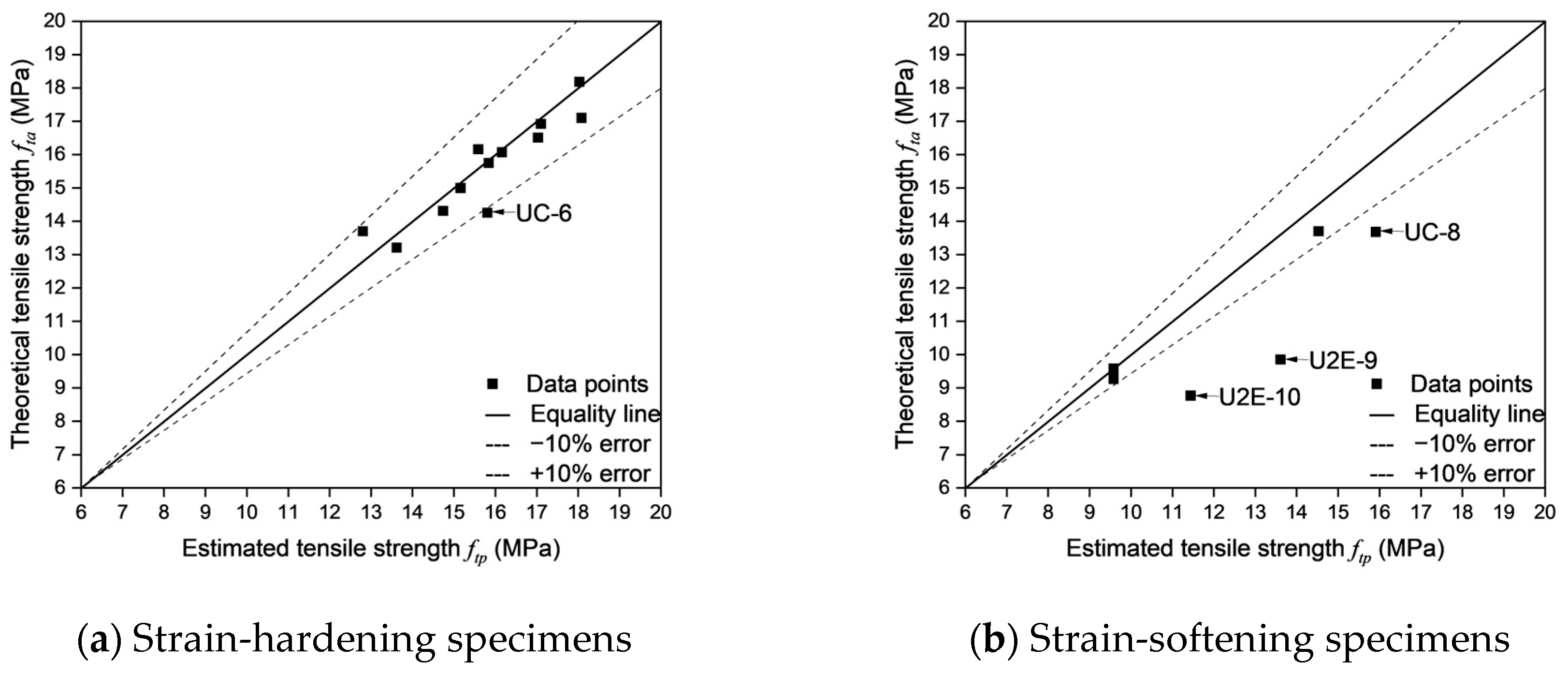To account for this behavior, subsequent tensile strength estimations in this study utilize an approach that averages the fiber count across all cross-sections within both the predicted and actual cracking locations. By averaging fiber counts across the cracking location, this method provides a more accurate representation of the structural interactions and stress distributions that contribute to the ultimate failure of the material.
3.4.2. Error Analysis of the Theoretical Tensile Strength
Equation (7) assumes a uniform distribution of fibers within the material. However, in actual processing and manufacturing, factors such as fiber flowability, interfacial interactions, and the geometric constraints of the structural component can induce local variations in fiber orientation and volume fraction. These deviations may affect the accuracy of tensile strength estimations, thereby leading to errors between the estimated tensile strength (fte) and experimental tensile strength (ft).
To address this issue, this study first calculates the theoretical tensile strength (fta) at the actual cracking locations, which serves as a baseline reference. In actual cracking locations, fibers undergo realignment under external loading, ensuring that the orientation and volume fraction more accurately reflect the material’s behavior under applied stress. Therefore, the tensile strength in this region provides a more reliable representation of the fiber reinforcement effect and serves as a benchmark for the estimated tensile strength (fte).
Table 9 compared the theoretical tensile strength (
fta) with the experimental tensile strength (
ft) in order to quantify the influence of fiber distribution on tensile strength. This approach effectively compensates for the errors introduced by the uniform distribution assumption, ensuring that the estimated values align more closely with the actual mechanical behavior of the material, thereby improving the accuracy and engineering applicability of the computational model.
As shown in
Figure 22, the errors between the theoretical tensile strength and the experimental tensile strength were calculated for different fracture modes. Except for UC-7, the calculation errors for all strain-hardening specimens are within 10%, which falls within the acceptable range. This indicates that Equation (7) can accurately estimate the tensile strength of strain-hardening specimens.
For UC-7, as shown in
Figure 23, the CT images of the actual cracking locations reveal a notably poor fiber distribution in this region, with some areas at the top of the specimen completely devoid of fibers. This observation stands in stark contrast with the tensile strength formulas Equation (7), which typically assume a uniform fiber distribution—i.e., that fibers across all regions contribute equally to load bearing and crack bridging. In practice, however, fiber distribution is frequently heterogeneous; for example, CT images indicate that the upper region of the specimen is sparsely reinforced, whereas the lower region exhibits a denser fiber arrangement. Consequently, the fiber-sparse areas demonstrate inadequate bridging capability, resulting in elevated localized stresses under tensile loading, given that the matrix’s tensile strength is substantially lower than that of the fibers. As a crack initiates in such a vulnerable area, the insufficient fiber reinforcement cannot effectively impede further crack propagation, leading to significant stress concentration and premature local failure. This discrepancy between the assumed uniform stress distribution in the formulas in the literature and the actual localized failures and stress concentrations ultimately leads to estimated tensile strengths that exceed those measured experimentally.
In contrast, for strain-softening specimens, the theoretical tensile strengths are consistently higher than the experimental tensile strengths and the errors are larger than 10%. This overestimation arises from Equation (7)’s inherent assumption of strain-hardening behavior, which overemphasizes fiber contributions. In strain-softening specimens, once the initial crack forms, the material fails to sustain its stress level, and its load-bearing capacity gradually declines as the crack propagates. This behavior contrasts with that of strain-hardening specimens, which, after crack formation, continue to bear higher tensile loads through fiber bridging and demonstrate greater toughness during crack propagation. The inherent nature of strain-softening specimens implies that once a crack forms, the matrix’s contribution rapidly diminishes, rendering the specimen’s load-bearing capacity almost entirely dependent on fiber bridging. However, in actual tests, the fiber bridging effect often falls short of the idealized state assumed in computational models, resulting in experimentally measured tensile strengths that are lower than theoretical predictions.
This overestimation primarily arises from several key assumptions in the estimations. Firstly, the model assumes that all fibers are uniformly distributed and fully contribute to the bridging effect. However, in strain-softening specimens, rapid crack propagation induces localized stress concentrations, causing some fibers to be inadequately stressed or even pulled out before the crack fully develops.
Secondly, the interfacial bond strength of the fibers is a critical factor influencing the bridging effect. In strain-softening specimens, swift crack propagation typically results in fiber failure predominantly by pull-out rather than rupture. Although computational models assume that fibers can provide their maximum bridging force, in practice, due to matrix interfacial defects, stress concentrations, and shear slip between the fiber and the matrix, many fibers fail to reach their theoretical maximum load capacity and are instead pulled out at lower stress levels. This interfacial effect further reduces the actual tensile strength, thereby contributing to the discrepancy between calculated and experimental values.
In summary, the rapid crack propagation, the brief duration of effective fiber bridging, and interfacial effects in strain-softening specimens often result in an actual tensile strength that is lower than the estimated value.
3.4.3. Evaluation of Experimental and Estimated Tensile Strength
The actual cracking locations, predicted cracking locations, estimated tensile strength (
fte), and theoretical tensile strength (
fta) were summarized alongside the experimental tensile strength (
ft). The errors between the estimated tensile strength (
fte), theoretical tensile strength (
fta), and experimental tensile strength (
ft) were analyzed by examining experiment-estimation error (
Eexp) and theory-estimation error (
Etheo) in
Table 10.
Etheo was introduced to minimize the influence mentioned in
Section 3.3.2 that could affect the results. Specifically,
fta, calculated at the actual cracking location, serves as a benchmark to better evaluate the accuracy of
fte, estimated at the predicted cracking locations.
As shown in
Table 10, the accuracy of cracking location predictions plays a crucial role in determining the reliability of tensile strength estimation in UHPFRC. Moreover, an analysis of the fracture behavior of specimens reveals distinct trends in both error magnitudes and the effectiveness of cracking location predictions. In particular, strain-hardening specimens exhibit higher estimation accuracy and lower errors, with an average experiment-estimation error of 5.72% and an average theory-estimation error of 3.34%. While strain-softening specimens display greater deviations between predicted and actual crack locations, resulting in significantly higher errors (an average experiment-estimation error of 43.09% and an average theory-estimation error of 15.73%). These findings further indicate that successful cracking location predictions correspond to lower experiment-estimation errors and theory-estimation errors, while failed predictions lead to increased deviations—especially in strain-softening specimens.
Strain-hardening specimens generally demonstrated more reliable cracking location predictions, with the majority of specimens classified as successful predictions. Such behavior can be attributed to a more uniform fiber distribution and enhanced fiber-matrix interaction, which in turn effectively controls crack propagation and facilitates the formation of multiple distributed cracks before ultimate failure. For instance, as shown in
Figure 24a and
Figure 25a, UC-4, UEE-1, and UEE-2, all of which had successful cracking location predictions, demonstrated low experiment-estimation errors and theory-estimation errors. Specifically, UC-4, with an actual cracking location of 45–55 and a predicted location of 40–60, had an experiment-estimation error of only −5.72% and a theory-estimation error of −3.39%, which suggests that the fiber distribution and orientation factors were sufficient to accurately predict tensile failure. Similarly, UEE-1, which has an actual cracking location of 10–18 (predicted cracking location: 10–20), showed an experiment-estimation error of 4.02% and a theory-estimation error of 3.57%, thereby reinforcing the notion that cracking prediction in strain-hardening specimens is highly reliable due to their controlled failure mechanism and effective fiber bridging.
However, not all strain-hardening specimens demonstrated perfect alignment between predicted and actual cracking locations. Specifically, certain specimens, including U2E-4 and UC-6, did not yield accurate cracking location predictions, which lead to larger deviations in errors despite their strain-hardening behavior. For example, U2E-4 had an actual cracking location of 53–63, while its predicted cracking location was 30–40, resulting in an experiment-estimation error of 10.06% and a theory-estimation error of −6.55%. Similarly, UC-6 exhibited an experiment-estimation error of −10.20% and a theory-estimation error of −10.92%, despite its classification as a strain-hardening specimen. These observations suggest that, even among strain-hardening specimens, localized fiber orientation inconsistencies may contribute to unpredictability in crack formation—although to a significantly lesser extent than in strain-softening specimens. The relatively low standard deviation in errors across strain-hardening specimens further indicates that these deviations are minor and do not fundamentally alter the predictability of tensile behavior.
In contrast, as shown in
Figure 24b and
Figure 25b, strain-softening specimens exhibited considerably larger deviations between predicted and actual cracking locations, which lead to substantially higher error values. Unlike strain-hardening specimens, which tend to develop multiple cracks and undergo progressive damage, strain-softening specimens are characterized by a single dominant crack. Consequently, their failure mechanisms are highly sensitive to local fiber depletion zones. This leads to greater unpredictability in crack formation and increased dispersion of errors. For example, U2E-9 and U2E-10, which did not yield accurate cracking location predictions, exhibited extremely high errors. Specimen U2E-9, which had an actual cracking location of (−12)–(−2) instead of the predicted cracking location (0–10), had an experiment-estimation error of −58.81% and a theory-estimation error of −38.17%—one of the highest values recorded in this study. Similarly, U2E-10 exhibited an experiment-estimation error of −54.41% and a theory-estimation error of −30.50%, further highlighting the challenges of predicting cracking locations in strain-softening specimens. These large discrepancies indicate that predictive models, which often assume a relatively uniform fiber orientation, are unable to accurately capture the actual failure behavior of strain-softening specimens.
The primary reason for higher error magnitudes observed in strain-softening specimens is the unpredictability of fiber alignment, which significantly influences cracking location prediction. Unlike strain-hardening specimens, in which cracks propagate in a more controlled manner owing to uniform fiber bridging, strain-softening specimens tend to exhibit more erratic crack formation mainly due to localized fiber depletion and misalignment. This observation is further supported by the fiber orientation factor (μ₀), which is consistently lower in strain-softening specimens, thereby indicating a less favorable fiber alignment for tensile load resistance. Additionally, the high standard deviation in errors among strain-softening specimens confirms that these deviations are not random but are inherently linked to the variability in fiber distribution.
A key observation across both strain-hardening and strain-softening specimens is the strong direct correlation between successful cracking location prediction and reduced error magnitudes. The analysis revealed that specimens with successful cracking location predictions exhibited significantly lower errors compared to those with failed predictions, regardless of their fracture behavior. The average experiment-estimation error for successfully predicted specimens was −11.85%, while for failed predictions, it was −39.42%, a nearly fourfold increase. Similarly, theory-estimation errors in failed predictions were six times higher (−18.78%) compared to successful predictions (−2.94%). This emphasizes that accurately predicting the cracking location is critical in reducing error magnitudes in both strain-hardening and strain-softening specimens. However, while strain-hardening specimens consistently demonstrated lower errors even in cases of failed predictions, strain-softening specimens exhibited severe deviations, indicating that failure prediction in these specimens remains a significant challenge.
While fracture behavior is the primary determinant of cracking location prediction accuracy and error magnitudes, the casting method also influences fiber orientation and, consequently, error variability. The experimental results indicate that casting from end to end (UEE) produced the lowest errors, likely due to its ability to ensure a more uniform fiber distribution across the entire specimen length. In contrast, the casting-from-two-ends (U2E) method also resulted in the highest errors, likely due to fiber alignment disruptions at the central region where flow streams meet. These findings reinforce the notion that fiber uniformity plays a critical role in cracking location prediction, and casting techniques that promote homogeneous fiber orientation should be prioritized to minimize prediction errors.
Overall, the results confirm that strain-hardening specimens exhibit lower deviations between predicted and actual cracking locations, leading to smaller errors and more reliable tensile strength estimations. Conversely, strain-softening specimens, due to their localized failure modes and erratic crack propagation, display significantly larger deviations and higher errors, making accurate estimations more challenging. The success or failure of cracking location prediction further amplifies these differences, with failed predictions corresponding to significantly higher error magnitudes. Finally, the role of casting methods in fiber orientation should not be overlooked, as more uniform casting approaches can reduce variability in crack formation and enhance the reliability of estimable models.
These findings emphasize the necessity for improved fiber distribution techniques and refined estimable models that account for stochastic fiber orientation effects, particularly in strain-softening UHPFRC specimens, where failure mechanisms remain highly variable. By incorporating enhanced fiber alignment strategies and optimizing casting methodologies, the predictability of crack formation and tensile response in UHPFRC can be significantly improved, leading to more accurate and reliable structural performance assessments.
While these findings clarify the limitations and strengths of the proposed method within different fracture behavior categories, it is also crucial to critically compare this approach against previous tensile strength estimation methodologies to further highlight its novelty and practical advantages.
Compared to previous tensile strength estimation frameworks such as SIA 2052-2016 [
34] and the local distribution model by Shen et al. [
33], the proposed method introduces two key advancements. Firstly, traditional models assume that critical cracking sections are known beforehand, requiring destructive sectioning to analyze fiber characteristics after specimen failure. This restricts their application in non-destructive testing and pre-emptive quality assurance. Secondly, by neglecting pre-crack localization and casting-induced fiber distribution variability, these models often exhibit reduced predictive reliability, especially in strain-softening UHPFRC.
In contrast, the present study leverages deep learning-based cracking location prediction combined with localized CT image fiber analysis, thereby enabling pre-failure strength estimation. This integrated methodology not only demonstrated high accuracy for strain-hardening specimens—with an average experimental-estimation error of 5.72%—but also provided insights into limitations in strain-softening specimens, thus presenting a more comprehensive and practical framework for UHPFRC tensile performance assessment.
